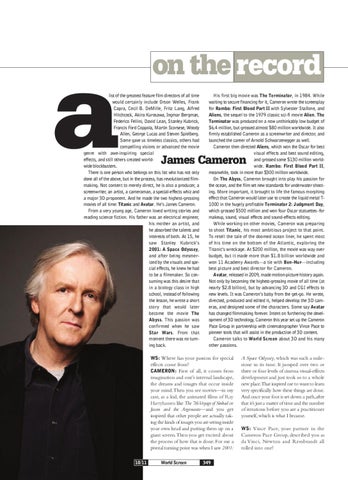WS_1011_RECORD_WSN_0406_RECORD 9/15/11 9:14 PM Page 3
on the record list of the greatest feature film directors of all time would certainly include Orson Welles, Frank Capra, Cecil B. DeMille, Fritz Lang, Alfred Hitchcock, Akira Kurosawa, Ingmar Bergman, Federico Fellini, David Lean, Stanley Kubrick, Francis Ford Coppola, Martin Scorsese, Woody Allen, George Lucas and Steven Spielberg. Some gave us timeless classics, others had compelling visions or advanced the movie genre with awe-inspiring special effects, and still others created worldwide blockbusters. There is one person who belongs on this list who has not only done all of the above, but in the process, has revolutionized filmmaking. Not content to merely direct, he is also a producer, a screenwriter, an artist, a cameraman, a special-effects whiz and a major 3D proponent. And he made the two highest-grossing movies of all time: Titanic and Avatar. He’s James Cameron. From a very young age, Cameron loved writing stories and reading science fiction. His father was an electrical engineer, his mother an artist, and he absorbed the talents and interests of both. At 15, he saw Stanley Kubrick’s 2001: A Space Odyssey, and after being mesmerized by the visuals and special effects, he knew he had to be a filmmaker. So consuming was this desire that in a biology class in high school, instead of following the lesson, he wrote a short story that would later become the movie The Abyss. This passion was confirmed when he saw Star Wars. From that moment there was no turning back.
His first big movie was The Terminator, in 1984. While waiting to secure financing for it, Cameron wrote the screenplay for Rambo: First Blood Part II with Sylvester Stallone, and Aliens, the sequel to the 1979 classic sci-fi movie Alien. The Terminator was produced on a now unthinkably low budget of $6.4 million, but grossed almost $80 million worldwide. It also firmly established Cameron as a screenwriter and director, and launched the career of Arnold Schwarzenegger as well. Cameron then directed Aliens, which won the Oscar for best visual effects and best sound editing, and grossed some $130 million worldwide. Rambo: First Blood Part II, meanwhile, took in more than $300 million worldwide. On The Abyss, Cameron brought into play his passion for the ocean, and the film set new standards for underwater shooting. More important, it brought to life the famous morphing effect that Cameron would later use to create the liquid metal T1000 in the hugely profitable Terminator 2: Judgment Day, which grossed $500 million and won four Oscar statuettes–for makeup, sound, visual effects and sound-effects editing. While working on other movies, Cameron was preparing to shoot Titanic, his most ambitious project to that point. To retell the tale of the doomed ocean liner, he spent most of his time on the bottom of the Atlantic, exploring the Titanic’s wreckage. At $200 million, the movie was way over budget, but it made more than $1.8 billion worldwide and won 11 Academy Awards—a tie with Ben-Hur—including best picture and best director for Cameron. Avatar, released in 2009, made motion-picture history again. Not only by becoming the highest-grossing movie of all time (at nearly $2.8 billion), but by advancing 3D and CGI effects to new levels. It was Cameron’s baby from the get-go. He wrote, directed, produced and edited it, helped develop the 3D cameras, and designed some of the characters. Some say Avatar has changed filmmaking forever. Intent on furthering the development of 3D technology, Cameron this year set up the Cameron Pace Group in partnership with cinematographer Vince Pace to pioneer tools that will assist in the production of 3D content. Cameron talks to World Screen about 3D and his many other passions.
James Cameron
WS: Where has your passion for special
effects come from? CAMERON: First of all, it comes from imagination and one’s internal landscape, the dreams and images that occur inside your mind. Then you see movies—in my case, as a kid, the animated films of Ray Harryhausen like The 7thVoyage of Sinbad or Jason and the Argonauts—and you get inspired that other people are actually taking the kinds of images you are seeing inside your own head and putting them up on a giant screen. Then you get excited about the process of how that is done. For me a pivotal turning point was when I saw 2001: 10/11
World Screen
349
A Space Odyssey, which was such a milestone in its time. It jumped over two or three or four levels of cinema visual-effects development and just took us to a whole new place.That inspired me to want to learn very specifically how these things are done. And once your foot is set down a path, after that it’s just a matter of time and the number of iterations before you are a practitioner yourself, which is what I became. WS: Vince Pace, your partner in the
Cameron Pace Group, described you as da Vinci, Newton and Rembrandt all rolled into one!
